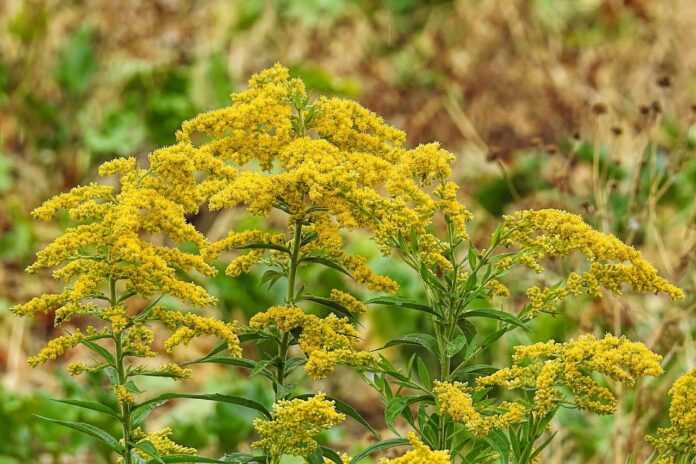The beginning of fall always stirs up mixed emotions. Part of me wants to throw on a flannel shirt and skip through the falling leaves with a pumpkin spice coffee in my hand. The other part of me wants to continue floating down a river on a raft under the endless summer sun.
The wildflowers and plants on my daily walk are telling me that it is time to embrace fall and all the changes it brings. The path I walk feels narrower. The tall stalks tipping towards the trail are weighed down with golden yellow and deep purple flowers.
Ironweed
The crimson-like purple flowers are giant ironweed, vernonia gigantea. The native plant species is a member of the Asteraceae or aster family. Just like the colors catch my eye, butterflies are attracted to the flowers shaped like miniature pipes. Even though the word weed is in the name, the attractive wildflower is related to sunflowers and all the composite flowers of the aster family.
I like seeing the splash of purple on my hike, but some farmers see the plant as a nuisance due to its toxic nature. It produces many seeds that can scatter into pastures. Giant ironweed is especially harmful to grazing livestock when ingested.
A complementary color to purple on the color wheel is yellow. Matching the deep hue of the purple giant ironweed, wingstem brought splashes of buttery yellow to the canvas of my hike.
Wingstem is another native species sometimes called yellow ironweed. It is wonderful for butterflies and moths, serving as a larval host. It has the same issues as its purple counterpart, it spreads easily and can be a nuisance in the wrong place.
Mistaken identity
Another yellow plant along the trail is often a victim of mistaken identity. Both are members of the Asteraceae family and bloom at the same time in the fall. Goldenrod is often erroneously called ragweed. The difference between the two starts with an aaachoooo! The bright yellow flowers of goldenrod do not trigger an allergic response like pollen from ragweed.
Although similar in size at the beginning of the season, goldenrod is a perennial plant related to daisies. Ragweed, while native and found in every state except Alaska, is a noxious weed that competes with other plants and crops for resources.
Goldenrod is often used to attract pollinators to a garden. Honey bees get both nectar and pollen from goldenrod. Other species of bees including sweat bees and bumblebees also visit goldenrod plants frequently.
Instead of being insect-pollinated, ragweed is pollinated by the wind. Most people who suffer from sinusitis in the fall season are reacting to ragweed pollen. Each plant only lives for one season, but one plant can produce up to a billion pollen grains. The wind is used to spread the pollen from male plants to female plants for reproduction.
In comparison, goldenrod offers health benefits and does not trigger seasonal allergies. It can be made into tea or tinctures used to treat a variety of ailments including inflammation, arthritis, and skin issues. Traditionally, goldenrod was used as a diuretic. Practitioners in some European nations continue to use goldenrod as a diuretic with their patients.
The easiest way to tell the difference between goldenrod and ragweed is to look at the blooms. Goldenrod’s blooms are larger and more vivid yellow in comparison to ragweed. Common ragweed can grow up to 6 feet tall; giant ragweed can reach heights up to 8 feet tall. Goldenrod tends to be 4 feet tall or shorter with long, tapered leaves by the end of the growing season.

Jewelweed
Another native wildflower growing in abundance along the trail is jewelweed. It stands out amongst the goldenrod and wingstem because its leaves are a darker shade of green. Bright orange or yellow blooms dangle above the seed pods.
The bright orange flowers, after a closer look, have darker red spots. Another name for the flowers is “spotted touch-me-not.” My kids love to find the seed pod and watch the seeds burst out. A very beneficial wildflower, jewelweed can be used to treat poison ivy along with other skin ailments.
A lot of people see autumn as the beginning of the end of the growing season. With a discerning eye, there is still beauty and usefulness in many of the late-blooming plants. Although the seasons change, there is never a dull moment or a lack of beauty. And an occasional sneeze…














